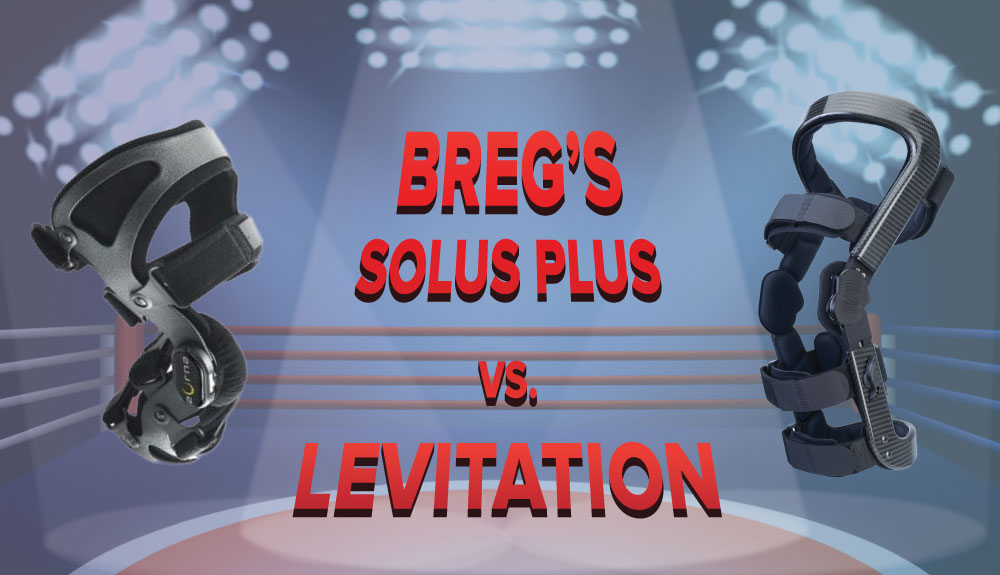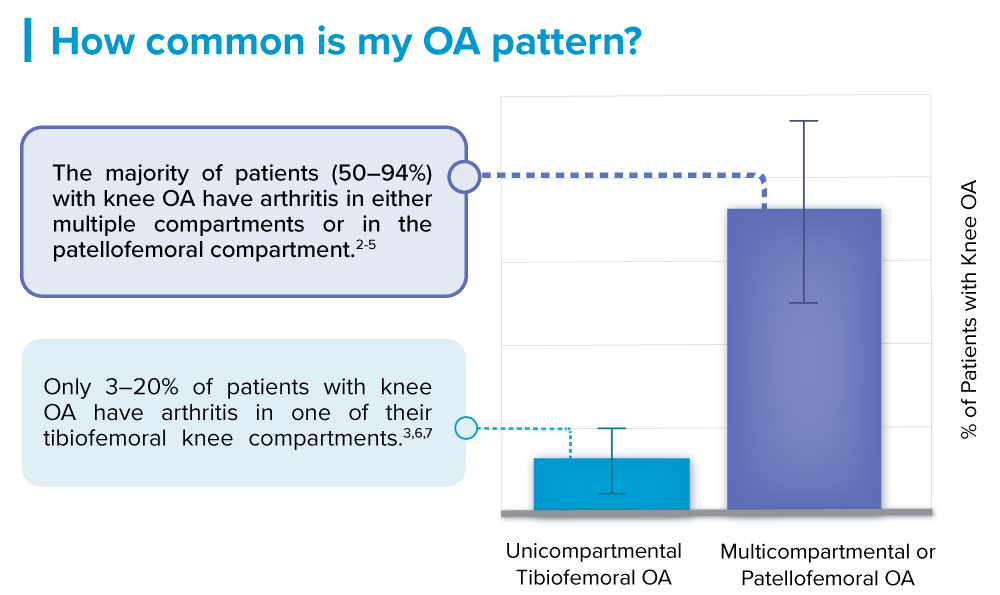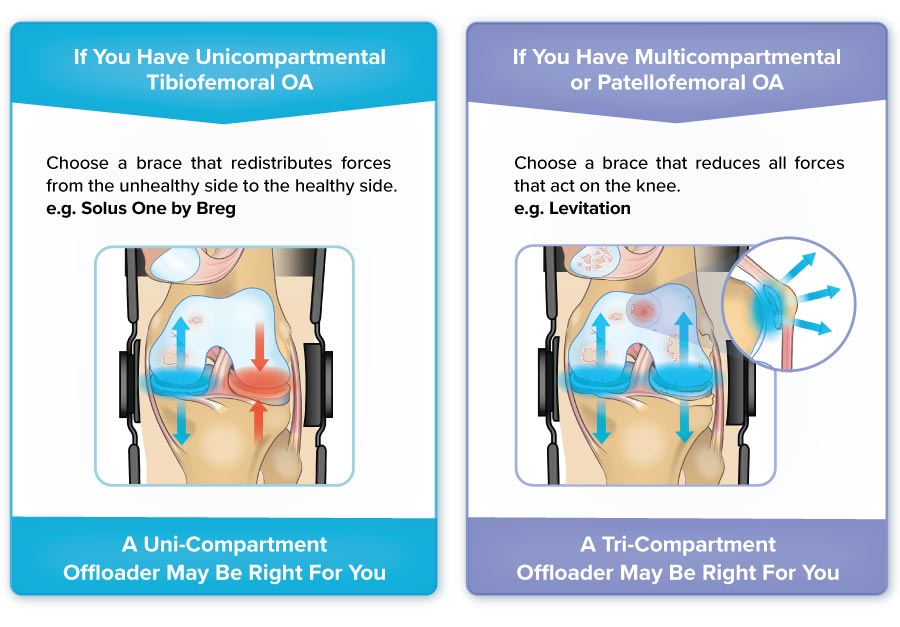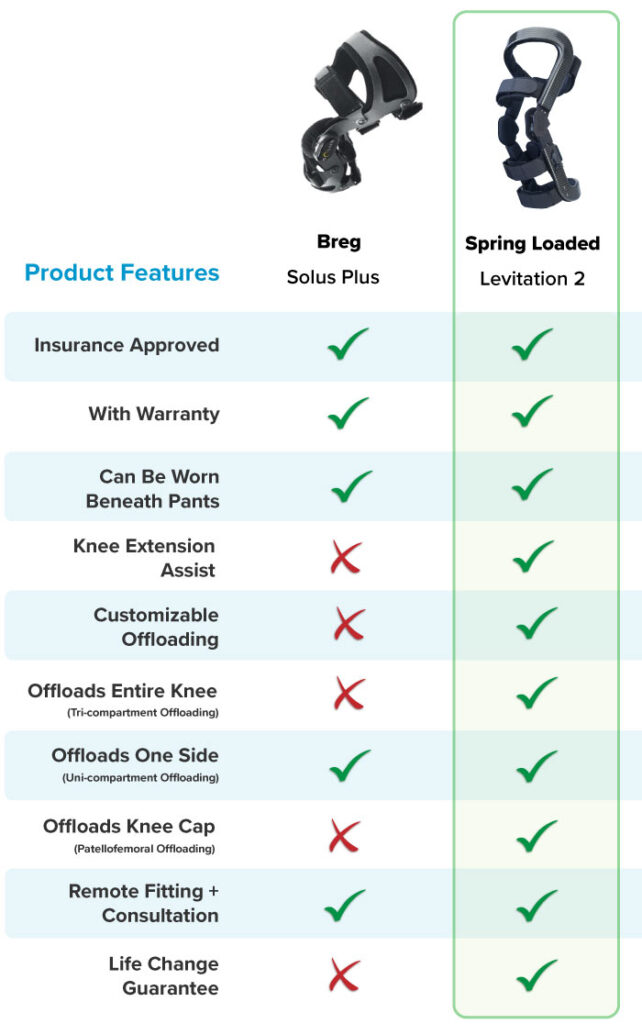The Breg Knee Brace vs Levitation

Shopping for the perfect knee brace for your osteoarthritis can be a confusing experience. To make your life easier, our brace smackdown will compare a popular Breg knee brace, the Solus Plus, with a bionic brace created by Spring Loaded.
The Solus Plus is a brace made for treating osteoarthritis on one side of the knee (unicompartmental tibiofemoral OA). This Breg knee brace, in addition to the Freestyle OA, is a brace that Breg describes as a “push” design. This design is characterized by an adjustable dial on the side of the knee that applies a load on the joint.
Breg also offers a second brace design, the “pull,” which uses a series of ratchet buckles to apply a load to the knee. However, this article will only focus on the Solus Plus, since it allows for easier adjustments than the “pull” braces. For simplicity, we will refer to the Solus Plus as the Breg knee brace or just Breg in this article.
Levitation is the flagship product of Spring Loaded. As the world’s first bionic brace, Levitation powers leg extension and reduces pressure across the entire knee. As a result of its cutting-edge technology, Levitation has improved the lives of patients suffering from a variety of conditions, such as osteoarthritis, meniscus damage, and ligament injuries, among others.
Introduction
Levitation and Breg share several features. Both are insurance approved, come with a warranty, and can be worn beneath your pants. They can also offload one side of the knee, so if you suffer from unicompartmental tibiofemoral arthritis, like approximately 3–20% of patients with osteoarthritis,1-2 both braces can provide the pain relief you are looking for.
But because this article is a brace smackdown, these features likely won’t persuade you one way or the other. Read on for our full breakdown of the key differences.

Offloading: Breg Knee Brace vs Levitation
The Breg knee brace and other traditional offloader braces work by redistributing pressure from one side of the knee to the other side. If you have osteoarthritis in only one knee compartment, not including your knee cap, this system of redistributed pressure can provide sufficient relief.
But if you are like most osteoarthritis patients, you have osteoarthritis in more than one knee compartment or in your knee cap.4,5 Because Levitation works by offloading pressure across the entire knee, including the knee cap, its users with osteoarthritis in one or more knee compartments can discover pain relief across the entire knee.3 Further proof that Levitation’s offloading capabilities are impressive? Levitation users with knee OA have seen their knee pain reduced by 95%6, and their mobility increased by 85%7.

Custom Features: Breg Knee Brace vs Levitation
The Breg knee brace features the brand’s exclusive thumbwheel hinge technology. The thumbwheel is located on the side of the hinge and allows for additional adjustments to knee off-loading. Take note that the adjustments only pertain to the distribution of forces between the two sides of your knee.
The Levitation knee brace can be customized to meet your changing mobility needs. The brace can be adjusted to two power modes: High Power and Low Power. These options allow you to choose how much of an assist you get from the brace, as well as the range of motion over which it is active. If you are performing energy-intensive actions, such as deep knee bends, you can set your brace to High Power mode and get an extra boost of power during your leg extensions. If your activity is less demanding or your leg strength has increased, you can set your brace to Low Power mode and still enjoy the benefits of an assist at a lessened intensity.
Knee Cap Offloading: Breg Knee Brace vs Levitation
The Breg knee brace and other traditional offloader braces are unable to treat pain caused by osteoarthritis in the knee cap (patellofemoral compartment). This is because these braces only redistribute pressure from one tibiofemoral compartment to the other tibiofemoral compartment, resulting in little to no pressure relief to the knee cap.5
However, Levitation offloads the entire knee and can relieve symptoms that occur in the knee cap.3 If your knee pain originates in the knee cap, Levitation is your only bracing option that can provide the pain relief you are looking for.
Knee Extension Assist: Breg vs Levitation
A knee extension assist is unique to the Levitation brace. Located within liquid springs stored in the hinge, the assist is what distinguishes Levitation as a bionic brace.
This is how the knee extension assist works: During a knee bend, the liquid springs inside the hinge store energy. When you extend your leg, the springs release the energy, which then powers your leg muscles. The assist feels like receiving a boost of power into your legs.
Furthermore, the assist is highly powerful too. With the brace, joint impact is reduced by an amount equivalent to losing 45 lb.3 With this amount of offloading, the assist effectively reduces bone-on-bone contact, which is a common indicator of osteoarthritis. By decreasing bone-on-bone contact, the assist helps with reduced pain and improved mobility.
Fitting & Consultation: Breg vs Levitation
For many knee braces on the market, including the Breg knee brace, fittings and consultations only occur in-clinic. The Breg knee brace is offered in 6 sizes, and the company recommends booking an appointment with an in-clinic bracing specialist to determine your correct size. Note that you will likely first need a prescription from a doctor for an osteoarthritis knee brace before you book an appointment at a clinic.
However, in light of the COVID-19 pandemic, Breg offers its patients Telehealth Support. Breg representatives correspond with your physician to help you get the products you need right at home. The service includes brace evaluations and fittings.
Levitation also serves its patients wherever they are located with remote fittings and consultations. Since Spring Loaded has had remote fittings and consultations from the start, their customer service is top-notch. Further benefits of remote consultations include reduced in-clinic wait times and the elimination of your personal transportation costs.
Special Guarantees: Breg Knee Brace vs Levitation
Based on the thousands of patients Spring Loaded has already helped with its bracing technology, the company is highly confident its brace can change your life, too. Specifically, its Life Change Guarantee states that you will get a prepaid return shipping label and a full refund if Levitation does not fundamentally change your life to your full satisfaction within the first 30 days. No hidden fees or surprises. Terms and conditions apply.
While Breg, like Levitation, offers standard warranties for its parts, it does not offer any special guarantees like the Life Change Guarantee.

The Winner? Most Likely Levitation
And there you have it: Breg versus Levitation. If your osteoarthritis is located in only one side of your knee, then both the Breg knee brace and Levitation can be a fit for you. Breg keeps it simple with its medial offloading technology, while the Levitation brace ups your game with its knee extension assist and custom offloading across the entire knee.
But if your osteoarthritis is located in multiple knee compartments or in your knee cap, Levitation wins hands down. With its full offloading capabilities, the Spring Loaded brace is the only brace on the market that can satisfactorily treat your pain symptoms. And lastly, with its Life Change Guarantee, you can feel confident in going forward with your brace purchase.
If you believe Levitation can help you do more of what you love, contact a bracing specialist at 1-877-209-8780 (toll-free) for a free consultation. You can also arrange to have a specialist contact you.
Hear what customers of Levitation have to say
How does Levitation’s bionic technology work?
More Reading
- Choosing a Knee Brace – Everything You Need to Know
- The Best Knee Brace for Osteoarthritis
- Top Five Offloader Knee Braces
- Donjoy Knee Brace vs. Levitation
- Managing My Knee Arthritis without Painkillers or Surgery
References
- Heekin, R. D. & Fokin, A. A. (2014). Incidence of bicompartmental osteoarthritis in patients undergoing total and unicompartmental knee arthroplasty: is the time ripe for a less radical treatment?. The journal of knee surgery, 27(01), 77–82. doi: 10.1055/s-0033-1349401
- Shahid, M. K., Al-Obaedi, O., & Shah, M. (2018). Prevalence of compartmental osteoarthritis of the knee in an adult patient population: A retrospective observational study. EC Orthopaedics, 9(10), 774–780.
- Budarick, A. R., MacKeil, B. E., Fitzgerald, S. & Cowper-Smith, C. D. (2019). Design and Mechanical Evaluation of a Novel Multi-Compartment Offloader Knee Brace. J. Biomech. Eng. doi:10.1115/1.4044818
- Duncan, R. C., Hay, E. M., Saklatvala, J., & Croft, P. R. (2006). Prevalence of radiographic osteoarthritis – it all depends on your point of view. Rheumatology, 45(6), 757–760. doi: 10.1093/rheumatology/kei270
- Hinman, R. S. & Crossley, K. M. (2007). Patellofemoral joint osteoarthritis: an important subgroup of knee osteoarthritis. Rheumatology, 46(7), 1057–1062. doi:10.1093/rheumatology/kem114
- Based on a retrospective systematic survey of Spring Loaded knee brace users with knee osteoarthritis.
- Based on a retrospective systematic survey of Spring Loaded brace users with knee osteoarthritis.
- McAlindon, T., Zhang, Y., Hannan, M., Naimark, A., Weissman, B., Castelli, W., & Felson, D. (1996). Are risk factors for patellofemoral and tibiofemoral knee osteoarthritis different?. J Rheumatol, 23(2), 332-337.
- Stefanik, J. J., Guermazi, A., Roemer, F.W., et al. (2016). Changes in patellofemoral and tibiofemoral joint cartilage damage and bone marrow lesions over 7 years: the Multicenter Osteoarthritis Study. Osteoarthritis Cartilage, 24(7), 1160-1166. doi:10.1016/j.joca.2016.01.981.
- Lankhorst, N.E., Damen, J., Oei, E.H, et al. (2017). Incidence, prevalence, natural course and prognosis of patellofemoral osteoarthritis: the Cohort Hip and Cohort Knee study. Osteoarthritis Cartilage, 25(5), 647-653. doi:10.1016/j.joca.2016.12.006.
Frequently Asked Questions
Depending on your pattern of knee osteoarthritis, a Breg knee brace or Levitation may be right for you. The Breg knee brace, such as the Solus Plus, only treats knee OA in one side of the knee (unicompartmental tibiofemoral osteoarthritis), while Levitation can treat all patterns of knee OA. Before buying a medical brace, be sure to speak to your healthcare provider or bracing specialist about your individual needs.
There are many differences between these braces, but a primary difference between them would be how they approach offloading knee joint forces. While the Solus Plus redistributes forces from the unhealthy side of the knee to the healthy side, Levitation offloads forces across the entire knee while also powering leg movements using an assist.
A Breg knee brace, such as the Solus Plus, can effectively treat specific patterns of knee osteoarthritis. The brace uses its condyle and strapping technology to redistribute forces from one side of the knee to the other side, making it best suited to treating unicompartmental tibiofemoral OA. However, if you have this condition or a different knee OA pattern, a knee brace like Levitation may be a better choice.